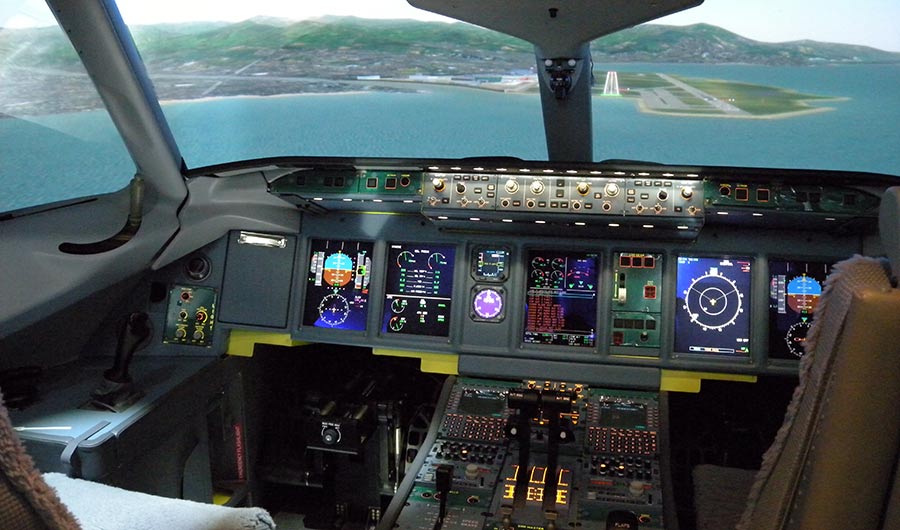When Pilots are Startled or Surprised Bad Things Can Happen

Image credits: SuperJet International via Flickr
Rights information: CC BY-SA 2.0
(Inside Science) -- On Jan. 15, 2009, Chesley Sullenberger III, the pilot on US Airways Flight 1549, took off from New York’s LaGuardia airport with 155 passengers and crew on board an Airbus A320. Almost immediately, the plane hit a flock of Canada geese.
Both engines lost almost all their thrust. Sullenberger knew exactly what to do.
He made a water landing in the Hudson River. A flight attendant and four passengers were seriously injured. No one died.
Other airline passengers are not always so lucky.
On June 1, 2009, flight 447, an Air France Airbus 330, was four hours into its nighttime flight from Rio de Janeiro to Paris when it entered a storm near the equator. As the weather rocked the plane, the cockpit window suddenly glowed an eerie blue-violet due to an electrical phenomenon called St Elmo’s Fire. Then, the autopilot disengaged. Instruments began giving conflicting measurements.
Alarms sounded, warning of an imminent stall. The plane soared from 35,000 feet to 38,000 feet and then plummeted at a rate of 10,000 feet per minute.
One pilot pushed the nose down to correct for a stall while the other pushed the nose up, countermanding the first. They continued to fall. The plane smashed into the ink-dark Atlantic, killing 288 people.
The crash was caused by a minor technical problem that has since been resolved by replacing the instruments in the nose of the plane that measure air speed, called pitot tubes. Investigators believe the tubes on flight 447 were clogged with ice and gave conflicting speed indications.
But confusion on the flight deck on a plane remains of great interest to scientists. More than 30 years ago, NASA developed a program called Cockpit Resource Management after several crashes in which cockpit crews were unable to cope with the unexpected. Most airlines use the program in their training. The Air France crew may have failed to use the procedure. Sullenberger had helped train crews and also helped develop the cockpit resource management approach used by US Airways.
Now, a group of Dutch scientists and graduate students has formulated a model of what happens in circumstances such as the fall of flight 447. It offers some guidance on how to train pilots to perform best when the unexpected happens.
In a paper published in the journal Human Factors, Annemarie Landman, a Ph.D. student at Delft University of Technology in the Netherlands and the research organization TNO, and her colleagues said one of the issues in training crews is the difference between startle and surprise, two different situations, both of which may contribute to aircraft accidents.
Flying through a storm and encountering turbulence, lightning or even more rare events can be startling but aren't a surprise. Having the autopilot shut off suddenly can be both a startle and a surprise, although pilots say that is not uncommon.
A startle happens suddenly and unexpectedly, like the sound of a pistol shot. Surprise, on the other hand, occurs when an event is baffling and doesn’t seem to make any sense. People react differently to both, and both can create stress.
The Air France pilots were likely both startled and surprised.
The increasing automation in the cockpit makes flight crews more vulnerable to startles and surprises, the researchers wrote.
Most people have the idea that pilots put the flight directions into the flight computer and then just sit and watch the instruments for the rest of the flight, sometimes for hours, said Patrick Smith, a commercial airline pilot and author of the blog Ask The Pilot. That’s not true, he said. They are in fact quite busy keeping the plane on track and communicating with air traffic control.
People often operate in what psychologists call frames that cover the situation they are in. When startled or surprised they must quickly change their frame to shift their mindset to assess the situation and react.
“You adjust your idea of the world to what the world actually is,” Landman said.
The Dutch researchers put two sets of pilots in simulators. One set was told about controllability problems they would face. The second had to figure it out for themselves as they happened.
The second group was better at shifting the frames because of the unpredictability of the scenarios they faced.
Smith said pilots undergoing simulator training can often guess what is going to happen during the “flight,” due to a pattern in the simulation. That makes it harder to shift frames when unforeseen events occur.
“I indeed found that pilots who received more unpredictable and diverse training scenarios performed better in a surprising test scenario,” Landman said.
“Even though training scenarios are never as surprising as an emergency in real flight,” Landman said, “unpredictability can still be used to practice frame shifts and the activities involved: gathering information, retrieving a frame, communicating your ideas with your copilot, testing if the frame is correct, comparing frames, etc."
Most airlines, including Air France, have changed their training to simulate what happened aboard the A330. Smith, however, says the real key may be to bring back the old-fashioned flying skills, such as knowing what to do in a high-altitude stall.
“Based on my model, I would guess that pilots who would be very well able to handle emergencies are those who have elaborate frames due to varied experience,” Landman wrote.
Pilots who are not trained as well will have fewer frames to draw from and “may fail to recognize the nuances of a particular situations, draw incorrect conclusions and then apply incorrect procedures,” Landman said.

